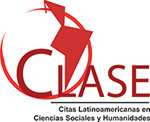Factors that influence Ecuadorian university students’ motivation towards English learning: An exploratory research study
DOI:
https://doi.org/10.23857/dc.v5i2.1122Palabras clave:
motivation, attitudes, university students, English.Resumen
Although learning English as a foreign language has commonly been associated with special cognitive abilities or learners’ aptitude, it has also been found that motivation plays a key role. Thus, this exploratory research study aimed to determine what factors motivate Ecuadorian university students to learn English, so a survey was administered to 422 students in different undergraduate programs from three public universities. The questions focused on learning about and determining the level of agreement the study participants had with statements related to integrative and instrumental motivation. Additionally, an open-ended question was formulated to find out the most important reasons behind their learning of English. The findings showed that a large number of study participants feel motivated to learn the language in order to achieve short-term goals such as traveling and being able to communicate in the target language, as well as long-term goals that include earning academic degrees and obtaining better job opportunities. It was concluded that the role of the teacher and an effective language teaching methodology are key components of students’ motivation and attitudes towards successful foreign language learning.
Citas
Al-Hazemi, H. (2000). Lexical attrition of some Arabic speakers of English as a foreign language: A study of word loss. The Internet TESL Journal. Retrieved from http://bit.ly/2kvqHkC
Al Mamun, S.A., Rahman, A.R.M.M., Rahman, A.R.M.R., & Hossain, M.A. (2012). Students’ attitudes towards English: The case of life Science School of Khulna University. International Review of Social Sciences and Humanities, 3(1), 200-209.
Al-Otaibi, G. (2004). Language learning strategy use among Saudi EFL students and its relationship to language proficiency level, gender, and motivation (PhD thesis). Indiana University of Pennsylvania, Indiana, Pennsylvania.
Bobkina, J. & Fernandez, M. (2012). Motivation and attitudes towards learning English: A study of engineering undergraduates at the Technical University of Madrid. Paper presented at the 5th International Conference of Education, Research and Innovation. Madrid, Spain, November.
Brophy, J. (1986). On Motivating Students. Occasional Paper No. 101. Institute for Research on Teaching at Michigan State University. Retrieved from http://bit.ly/2kcDEiV
Brown, H.D. (2000). Principles of language learning and teaching (4th ed.).
Englewood Cliffs, NJ: Prentice-Hall.
Crookes, G., & Schmidt R.W. (1991). Motivation: Reopening the research agenda. Language Learning, 4(41), 469-512.
Crystal, D. (2003). English as a global language. Cambridge: Cambridge University Press.
Ditual, R. C. (2012). The motivation for and attitude towards learning English. Asian EFL Journal, 63(1), 4-21.
Dí¶rnyei, Z. (1997). Motivational factors in the second language attainment: A review of research in Hungary. Acta Linguistica Hungraiana, 44, 261-275.
Dí¶rnyei, Z. (1990). Conceptualizing motivation in foreign language learning. Language Learning, 40(1), 45-78.
Dí¶rnyei, Z. & Ushioda, E. (2010). Teaching and researching: Motivation (2nd ed.). Abingdon-on-Thames, UK: Routledge.
Ehrman, E. (1996). Understanding second language learning difficulties. London: Sage Publications.
Ellis, R. (2008). The study of second language acquisition (2nd ed.). Oxford, UK: Oxford University Press.
Entwistle, N. & Tait, H. (1995). Approaches to studying and perceptions of the learning environment across disciplines. New Directions for Teaching and Learning, 64(1), 93-103.
Falk, J. (1978). Linguistics and language: A survey of basic concepts and implications (2nd ed.). New York: Wiley.
Gardner, R. C. & Lambert, W. (1972). Attitudes and motivation in second language learning. Rowley, MA: Newbury House Publishers.
Gardner, R. C. (1985). Social psychology in second language learning: The role of attitude and motivation. London: Edward Arnold.
Goktepe, F.T. (2014). Attitudes and motivation of Turkish undergraduate EFL students towards learning English language. Studies in English Language Teaching, 2(3), 314-332.
Heidari-Soureshjani, K. S. & Naseri, N. (2011). The Interrelationship of instrumental, integrative, intrinsic, and extrinsic motivations and the lexical-oriented knowledge among Persian EFL language learners. Theory and Practice in Language Studies, 1(6), 662-670.
Huang, C. (2007). Why do university students want to learn English? (Master thesis). Providence University, Taichung, Taiwán.
Hudson, G. (2000). Essential introductory linguistics. New Jersey, USA: Blackwell Publishers.
Lambert, W. E. (1955). Measurement of the linguistic dominance of bilinguals. Journal of Abnormal and Social Psychology, 50(2), 197-200.
Lambert, W. E. & Gardner, R. C. (1959). Motivational variables in second language
learning. Canadian Journal of Psychology, 13, 266-273.
Lepper, M. (1988). Motivational considerations in the study of instruction. Cognition and Instruction, 5(4), 289-309.
Lightbown, P. & Spada, N. (1993). How languages are learned. Oxford: Oxford University Press.
Mahreez, A. (1994). The factors influencing the Malaysian Chinese attitudes towards leaning English as a second language (Master thesis). University of Essex, Essex, England.
Moiinvaziri, M. (2009). Motivational orientation in English language learning: A study of Iranian undergraduate students using English. Retrieved from http://bit.ly/2kvtUAI
Moskovsky, C., & Alrabai, F. (2009). Intrinsic motivation in Saudi learners of English as a foreign language. The Open Applied Linguistics Journal, 2(1), 1-10.
Narayanan, R. (2006). Motivation variables and second language learning (Master thesis), Vinayaka Mission’s Research Foundation University, Kanchipuram, India.
Norris-Holt, J. (2001). Motivation as a contributing factor in second language acquisition. The Internet TESL Journal. Retrieved from http://bit.ly/2lM3U4h
Oxford, R. & Shearin, J. (1994). Language learning motivation: Expanding the theoretical framework. Modern Language Journal, 78(1), 12-28.
Pourhosein-Gilakjani, A., Leong, L. M. & Saburi, N. B. (2012). Study on the role of motivation in foreign language learning and teaching. Modern Education and Computer Science, 7, 9-16.
Redfield, M. R, Figoni, B. & Levin, D. (2009). University technology students integrative and instrumental motivation. Osaka Keidai Ronshu, 59(5), 149-156.
Reiter, B. (2017). Theory and methodology of exploratory social science research. Human Journals, 5(4), 130-150.
Riasati, M. (2012). EFL learners’ perception of factors influencing willingness to speak English in language classrooms: A qualitative study. World Applied Sciences Journal, 17(10),1287-1297.
Ryan, R. & Deci, E. (2000). Intrinsic and extrinsic motivation: Classic definitions and new directions. Contemporary Educational Psychology, 25, 54-67.
Sample, M. (2015). Authentic materials: A motivational tool for the EFL Classroom? Educational and Linguistics Research, 1(2), 100-119.
Saville-Troike, M. (2006). Introducing second language acquisition. New York: Cambridge University Press.
Schmidt, R., Boraie, D. & Kassabgy, O. (1996). Foreign language motivation: Internal structure and external connections. In R. Oxford (Ed.), Language learning motivation: Pathways to the new century (pp. 9–70). Honolulu: University of Hawaii Press.
Shenk, E. (2011). Instrumental, integrative, and intrinsic: A self-determination framework for orientations towards language in a Puerto Rican community. The Canadian Journal of Applied Linguistics, 14(1), 155-176.
Stern., H. H. (1983). Fundamental concepts of language teaching. Oxford: Oxford University Press.
Sugita, M. & Takeuchi, O. (2015). Motivational strategies in EFL classrooms: How do teachers impact students’ motivation. Innovation in Language Learning and Teaching, 8(1), 20-38.
Tahaineh, Y. & Daana, H. (2013). Jordanian undergraduates’ motivations and attitudes towards learning English in EFL context. International Review of Social Sciences and Humanities, 4(2),159-180.
Wan-er, Z. (2008). Motivation and language learning in the context of China.
Sino-US English Teaching, 5(4), 7-16.
Wang, B. (2009). Motivation and language learning. Asian Social Science, 5(1), 98-100.
Publicado
Cómo citar
Número
Sección
Licencia
Authors retain copyright and guarantee the Journal the right to be the first publication of the work. These are covered by a Creative Commons (CC BY-NC-ND 4.0) license that allows others to share the work with an acknowledgment of the work authorship and the initial publication in this journal.







